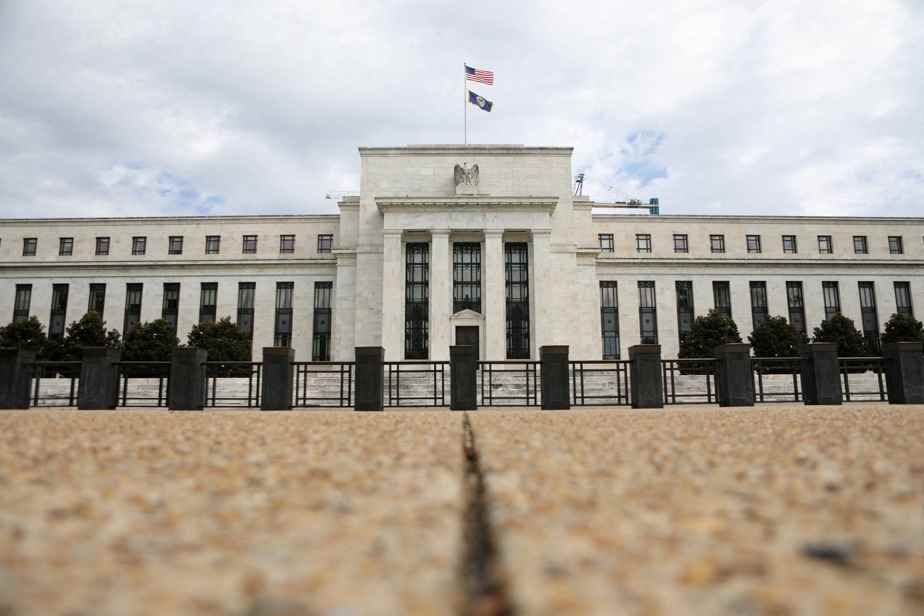(Washington) Another sharp rise in interest rates is in sight in the United States, where the central bank is desperate to slow economic activity to reduce inflation, and while the threat of recession complicates task.
Posted at 10:02
Officials of the Federal Reserve (Fed), the US central bank, have been meeting since Tuesday morning, and until Wednesday noon. The meeting of the monetary policy committee (FOMC) resumed Wednesday morning “at 9 a.m. as planned,” a spokesman for the Fed told AFP.
On the agenda for discussion: what should be the increase in the key interest rate to finally slow down the rise in prices? And when will we have to start to ease off on monetary tightening so as not to sink the economy?
A further increase of 0.75 points is largely anticipated by the markets, it would be the fourth in a row of this magnitude. The policy rate is currently between 3.00 and 3.25%.
The decision will be announced in a statement Wednesday at 2 p.m., and then Fed Chairman Jerome Powell will hold a press conference at 2:30 p.m.
But the institution should also indicate what it intends to do next, and signal “that the pace of increases should slow down in future meetings”, anticipates Steve Englander, head of US macro-economics for Standard Chartered, and former economist at the Fed.
It thus forecasts an increase of 0.50 point at the next meeting, in mid-December, and 0.25 point in January.
“Time to adapt”
“However, the Fed is more likely to suggest that it wants to give the economy time to adjust to changes in key rates, rather than indicating that it sees the need to reverse policy” , he nuances.
It takes months for rate hikes to have an effect on the economy.
Inflation was still in September at 6.2% over one year, close to its highest levels in more than 40 years, according to the PCE index favored by the Fed, whose objective is to bring it down to 2%.
Another measure, the CPI index, which refers in particular to the indexation of pensions, showed a price increase of 8.2% over one year in September.
With less than a week to go before the midterm elections, in which President Joe Biden risks losing his slim Democratic majority in Congress, inflation is now the main concern of American households.
But another danger threatens, since this voluntary slowdown in activity risks plunging the American economy into recession in 2023.
Jerome Powell had warned, at the end of the last meeting, in September, that there was no “painless way” to fight inflation durably.
Meanwhile, the United States recorded a quarter of growth between July and September, with +2.6% GDP growth at an annualized rate.
“First Signs”
As for the employment market, it still displays iron health. The official figures for October will be released on Friday, but we already know that private employers created 239,000 jobs in October, much more than in September, and much more than expected, according to figures released Wednesday.
“While we are seeing the first signs of a Fed-induced slowdown in (labour) demand, this is only affecting certain sectors of the labor market,” commented Nela Richardson, chief economist at ADP, quoted in the press release.
The Fed has already, since March, raised its rates five times, first by 0.25 points, then by 0.50, and finally, three times, by 0.75 points.
The Democrats, who had focused their campaign on the right to abortion, when the Republicans played the card of the fight against inflation, are now trying to put forward their economic program in favor of the middle classes.
Democratic Senator Sherrod Brown, Chairman of the Senate Banking Committee, sent a letter to Jerome Powell at the end of October, emphasizing that “the Fed’s fight against inflation should not make workers suffer”.
The credibility of the powerful institution is at stake because, after ensuring for months that high inflation would only be temporary, it has so far failed to slow it down.
However, the more households anticipate a lasting rise in prices, the more they act accordingly, and the more it becomes entrenched. This then requires even more painful measures, as in the early 1980s, after years of inflation sometimes approaching 15%.
